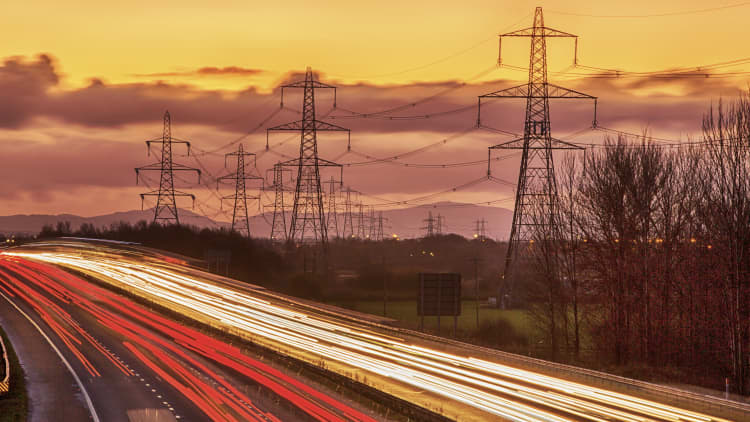[ad_1]
Jeffrey Lamb, Manager of extra high voltage stations for LADWP walks under the last tower delivering 3,210 megawatts 846 miles from the Columbia River in Oregon to the Sylmar Converter Station, a piece of power grid infrastructure operated by LADWP threatened by Oregon wildfires that almost caused the lights to go out in California on Friday night. The Sylmar Converter Station is the terminus of the Pacific DC Intertie, a giant power line that runs from the Columbia River to Southern California and one of two lines that was affected by the wildfire. The Pacific DC Intertie capacity is enough to serve two to three million Los Angeles households and represents almost half of the Los Angeles Department of Water and Power (LADWP) electrical system’s peak capacity. Sylmar on Monday, July 12, 2021 in Los Angeles, CA.
Al Seib | Los Angeles Times | Getty Images
Federal regulators voted unanimously on Thursday to approve rules that aim to speed up the process of connecting new power sources to the energy grid.
The rules could start to unclog a massive bottleneck that stands in the way of getting clean energy sources online to slow global warming, even if they aren’t a panacea.
related investing news


To connect a new power source, like a new wind or solar farm, to the electric grid, energy generators have to submit an interconnection application to a transmission operator, which enters them into a queue. Then the grid operator has to complete a series of studies to measure what equipment and upgrades will be necessary and how much the whole process will cost.
The entire electric grid in the U.S. has installed capacity of 1,250 gigawatts. There are currently 2,020 gigawatts of capacity in the interconnection queue lines around the country, according to a report published in April by the Lawrence Berkeley National Laboratory. That includes 1,350 gigawatts of power capacity — mostly clean — looking to be constructed and connected to the grid. The rest, 670 gigawatts, is for storage.
As all this power generation sits waiting in queues, the power grid is maxed out.
Last week, for example, the regional transmission organization that coordinates wholesale electricity movement in 13 states and the District of Columbia, PJM, issued an alert that the latest heatwave may drive electricity demand to the point that would require emergency operations. (In fact, it didn’t, and PJM canceled its alert at 5pm ET on Friday.)
Against this backdrop of an aging grid and soaring demand, the Federal Energy Regulatory Commission, the federal agency that regulates the transmission and wholesale sale of electricity, on Thursday voted to approve new rules to streamline and speed up the interconnection process.
Getting these rules approved has on its own been a massive bureaucratic effort. FERC took up the process of improving the generator interconnection process in July 2021 and in June 2022 issued specific proposed reforms. The notice of proposed rulemaking announcing those changes received 3,750 pages of comments by October, FERC said. Now, it will take a few more weeks or months for the rules to become official and go into effect.
MCKITTRICK, CA – APRIL 24: Oil pipelines, pumping rigs, and electrical transmission lines dot the landscape along California’s “Petroleum Highway” (Highway 33) running along the northwestern side of the San Joaquin Valley on April 24, 2020, near McKittrick, California. This area is known as the South Belridge Oil Field, and is part of the larger Belridge Producing Complex of Aera Energy LLC, which includes the smaller, but still substantial oil fields of North Belridge, Lost Hills, and Cymric, all in northwestern Kern County and 44 miles west of Bakersfield.
George Rose | Getty Images News | Getty Images
NWhat’s changing
Broadly speaking, the new rules include the following changes:
First-ready, first-served cluster process: Transmission providers have had to conduct separate studies for each power generation source that applies to connect to the grid. Now, transmission providers will be able to conduct larger, regional interconnection studies for clusters of power generation requests.
Also, power generators will have to meet certain requirements to keep their place in the queue, including a financial deposit.
Deadlines and penalties for transmission providers: Transmission providers will have strict deadlines to to respond to power generators waiting in the queue, and will face penalties if they miss those deadlines.
Generators can co-locate and share an interconnection request: The new rule requires transmission providers to allow co-located to submit one interconnection request, and the rule improves the process for this kind of application configuration. Also, power generators will be able to add a source of power to a single interconnection request. The rule also requires transmission providers to consider alternative transmission technologies.
This rule for co-locating is specifically going to help projects that have power generation and battery storage at the same spot. If a power generator wants to add a battery storage component to a project that is already in the queue, this will not qualify as a material modification that would require new studies and more delays.
Why new rules were needed
Among energy nerds, there’s a popular saying: “There’s no transition without transmission.”
For the United States to switch from generating electricity primarily from fossil fuels, like oil and gas, to renewable sources, like wind and solar, the system of wires that carry electricity from where it is generated to where it is used needs to be expanded.
That’s because, with fossil fuels, they could be burned to generate electricity near demand centers. But the most concentrated sources of renewable power are where the wind blows with the most force and the sun shines in the greatest intensity, and those locations are often far from cities and industrial areas.
The systems for building transmission lines developed when electricity demand was relatively flat. So although the process was been slow and burdensome, it wasn’t seen as an urgent problem to fix.
The increasing urgency around climate change has changed all of that. Wind and solar generators want to get their energy on the grid quickly. Also, decarbonizing existing industries often means electrifying them — the most obvious example being electric vehicles — which means demand for electricity will increase in coming years.
It can be so expensive to build new transmission, sometimes power generators can’t afford the cost and have to cancel their power generation plans completely. Also, power generators wait for an average of five years in these queues because grid operators are flooded with interconnection queue applications.
A hard fought and good first step
Generally, energy industry experts saw the vote to approve the rules as a first positive step.
“This order was a major undertaking. It’s impressive that a major nationwide rule was supported unanimously by all four Commissioners given the divisions in energy policy,” Rob Gramlich, the founder and president of the transmission grid policy shop Grid Strategies, told CNBC. “I think it will have a modest impact on moving projects through interconnection queues.”
The new rule increased tightened the interconnection queue application process for both energy generators and transmission operators, Gramlich said. “The final order preserves the balance from the proposed rule in which transmission providers and generators both have stiffer requirements,” Gramlich told CNBC.
Joseph Rand, an energy policy researcher at Lawrence Berkeley National Laboratory who leads the annual study on interconnection queues for the national lab, told CNBC the “rules are an incremental step in the right direction.”
Some of the independent regional grid system operators already have implemented some of the changes FERC voted for, like first-ready first-served cluster studies, Rand told CNBC, but not all transmission is regulated by regional independent system operators. In some parts of the country, utility companies regulate transmission. For those utilities, these rules “will be a bigger change,” Rand said, “and that means something.”
“For the non-ISO utilities, moving to a cluster process will be a big deal — in the ISOs there is pretty strong consensus that cluster studies have been a big improvement over the old serial process,” Rand told CNBC.
Generally, the rules were about what Rand expected to see come out of FERC, but he was surprised to see the financial penalties for transmission operators that don’t deliver interconnection studies.
“The financial penalties imposed on transmission providers for delayed studies could make a big difference, if they are indeed implemented with real teeth,” Rand told CNBC.
Also, the rule changes that will facilitate hybrid power generation and battery storage “could be a very big deal for unlocking storage and hybrid projects in the queues,” Rand said, pointing to the massive amount of battery storage in the interconnection queues already.
Gramlich was also “encouraged” to see some advanced transmission technologies, like advanced power flow control devices and advanced conductors, considered in the new rules.
Three sources of renewable energy – solar, wind & biogas. The Escalante Solar Project is a 240 MW photovoltaic array near Milford, Utah. Behind are the Milford Wind farm and Smithfield hog barns which produce biogas from hog waste.
Vw Pics | Universal Images Group | Getty Images
Gregory Wetstone, CEO of the non-profit renewable energy group American Council on Renewable Energy, said he was pleased that FERC got the rules approved, “but it is only a start.” He would like to see FERC require long-term transmission planning and for the “dysfunctional” method of paying for transmission upgrades to be reformed, among other things.
Like Wetstone of ACORE, Rand also said he was looking for FERC to institute rule changes surrounding long-term transmission planning.
“To be clear, the new rules, if implemented in tandem with the FERC’s separate proposed rule changes to transmission planning, could make an even bigger difference,” Rand told CNBC. “Much of the current backlog can be attributed to fundamental constraints and underinvestment in transmission — especially the longer-range, interregional variety — and the proposed transmission planning rules would help with that issue.”
Gramlich agreed.
“To achieve major impacts, they will need to address transmission planning and cost allocation which are teed up in the other major proposed rule before the Commission,” he told CNBC.

[ad_2]
Source link
